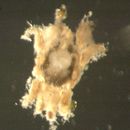Halacaridae is a family of meiobenthic mites found in marine, brackish, and freshwater habitats around the world. It includes more than 1100 described species belonging to 64 genera [1][2] It is the largest marine radiation of arachnids.[3]
Description and life cycle
Halacarids have four pairs of legs (as adults and nymphs; see below), of which the first two pairs point forwards and the last two pairs point backwards. This is a synapomorphy of the group. Another synapomorphy are four plates on the dorsal surface of the body, except for several genera with reduction of certain plates.[4]
The life cycle of halacarids consists of egg, larva, 1-3 nymphal stages (protonymph->deutonymph->tritonymph) and adult. Additionally, between each of the free-living stages (i.e. except for the egg) is a quiescent pupal stage.[5]
- Eggs are usually deposited by an adult female in a substrate, with the help of an ovipositor.
- Larvae have three pairs of legs, with each leg five-segmented, and lack a genital plate.
- Protonymphs have four pairs of legs (as do all following stages), of which the fourth pair is five-segmented, and they usually have a distinct genital plate.
- Deutonymphs and tritonymphs have each leg six-segmented.
- Adults are often similar to the last nymphal stage, but they have an ovipositor (if female) or spermatopositor (if male).
Like mites in general, halacarids have a pair of palps. The palps usually have four segments each, but they are three-segmented in Simognathus and just two-segmented in Acaromantis.[3]
Halacarids of subfamily Copidognathinae have just a single nymphal stage. Additionally, the number of genital papillae is reduced to a single pair.[3]
The subfamily Rhombognathinae, which is algivorous, can be recognised by the dark green or almost black pigment inside their digestive system. This pigment is partially digested chlorophyll from algae.[3]
Ecology
Halacaridae occur in various habitats including sandy beaches, tidal sediment, interstitial spaces, hydrothermal vents, mangroves, salt marshes and on larger animals.[2][6] They spend their entire lives on a substrate such as attached algae or sand.[3]
Most species and genera are predators, though Rhombognathinae are instead algivores.[3] In freshwater halacarids, some species are restricted to crayfish gill chambers, implying a parasitic lifestyle, while Lobohalacarus weberi is a scavenger that feeds on dead nematodes and oligochaetes but not on live ones.[7]
Phylogeny
Recent analyses place Halacaridae as the sister group to Parasitengona.[8][9] Within the group, algivorous Rhombognathinae consists of two lineages (Rhombognathus+Isobactrus and Rhombognathides+Metarhombognathus), meaning the habit of algivory has evolved two independent times.[3]
Genera
-
Acanthohalacarus Bartsch, 2001
-
Acanthopalpus Makarova, 1978
-
Acarochelopodia Angelier, 1954
-
Acaromantis Trouessart & Neumann, 1893
-
Acarothrix Bartsch, 1990
-
Actacarus Schulz, 1937
-
Agaue Lohmann, 1889
-
Agauides Bartsch, 1988
-
Agauopsis Viets, 1927
-
Anomalohalacarus Newell, 1949
-
Arhodeoporus Newell, 1947
-
Astacopsiphagus Viets, 1931
-
Bathyhalacarus Sokolov & Jankovskaja, 1968
-
Bradyagaue Newell, 1971
-
Camactognathus Newell, 1984
-
Coloboceras Trouessart, 1889
-
Colobocerasides Viets, 1950
-
Copidognathides Bartsch, 1976
-
Copidognathus Trouessart, 1888
-
Corallihalacarus Otto, 1999
-
Enterohalacarus Viets, 1938
-
Halacarellus Viets, 1927
-
Halacaroides Bartsch, 1981
-
Halacaropsis Bartsch, 1996
-
Halacarus Gosse, 1855
-
Halixodes Brucker & Trouessart, 1899
-
Hamohalacarus Walter, 1931
-
Himejacarus Imamura, 1957
-
Isobactrus Newell, 1947
-
Limnohalacarus Walter, 1917
-
Lobohalacarus Viets, 1939
-
Lohmannella Trouessart, 1901
-
Metarhombognathus
-
Mictognathus Newell, 1984
-
Parasoldanellonyx Viets, 1929
-
Parhalixodes Laubier, 1960
-
Pelacarus Bartsch, 1986
-
Peregrinacarus Bartsch, 1999
-
Plegadognathus Morselli, 1981
-
Porohalacarus Thor, 1922
-
Porolohmannella Viets, 1933
-
Rhombognathides Viets, 1927
-
Rhombognathus Trouessart, 1888
-
Ropohalacarus Bartsch, 1989
-
Scaptognathides Monniot, 1972
-
Scaptognathus Trouessart, 1889
-
Simognathus Trouessart, 1889
-
Soldanellonyx Walter, 1917
-
Spongihalacarus Otto, 2000
-
Stygohalacarus Viets, 1934
-
Thalassacarus Newell, 1949
-
Thalassarachna Packard, 1871
-
Thalassophthirius Bartsch, 1988
-
Troglohalacarus Viets, 1937
-
Tropihalacarus Otto & Bartsch, 1999
-
Werthella Lohmann, 1907
-
Werthelloides Bartsch, 1986
-
Winlundia Newell, 1984
-
Xenohalacarus Otto, 2000
References
-
^ Durucan, Furkan (2018). "New record of the genus Scaptognathus (Acari: Halacaridae) from Antalya with a checklist of marine halacarid mites of Turkey". Turkish Journal of Zoology. 42 (4): 499–507. doi:10.3906/zoo-1803-6.
-
^ a b Bartsch, Ilse (2009). "Checklist of marine and freshwater halacarid mite genera and species (Halacaridae: Acari) with notes on synonyms, habitats, distribution and descriptions of the taxa" (PDF). Zootaxa. 1998: 1–170. doi:10.11646/zootaxa.1998.1.1.
-
^ a b c d e f g Pepato, Almir R.; Vidigal, Teofânia H.D.A.; Klimov, Pavel B. (2018). "Molecular phylogeny of marine mites (Acariformes: Halacaridae), the oldest radiation of extant secondarily marine animals". Molecular Phylogenetics and Evolution. 129: 182–188. doi:10.1016/j.ympev.2018.08.012. PMID 30172010.
-
^ Harvey, MS (1989). "Pezidae, a new freshwater mite family from Australia (Acarina : Halacaroidea)". Invertebrate Systematics. 3 (6): 771. doi:10.1071/it9890771. ISSN 1445-5226.
-
^ Bartsch, Ilse (2015-02-17). "The genital area of Halacaridae (Acari), life stages and development of morphological characters and implication on the classification". Zootaxa. 3919 (2): 201–259. doi:10.11646/zootaxa.3919.2.1. ISSN 1175-5334. PMID 25781126.
-
^ Bartsch, I. (2003). "Mangrove halacarid fauna (Halacaridae, Acari) of the Dampier region, Western Australia, with description of five new species". Journal of Natural History. 37 (15): 1855–1877. doi:10.1080/00222930110089184. ISSN 0022-2933. S2CID 85063373.
-
^ Proctor, H.C. (2009), "Hydrachnida (Water Mites)", Encyclopedia of Inland Waters, Elsevier, pp. 335–345, doi:10.1016/b978-012370626-3.00176-9, ISBN 978-0-12-370626-3, retrieved 2022-10-14
-
^ Pepato, A R; Klimov, P B (2015). "Origin and higher-level diversification of acariform mites – evidence from nuclear ribosomal genes, extensive taxon sampling, and secondary structure alignment". BMC Evolutionary Biology. 15 (1): 178. doi:10.1186/s12862-015-0458-2. ISSN 1471-2148. PMC 4557820. PMID 26330076.
-
^ Dabert, Miroslawa; Proctor, Heather; Dabert, Jacek (2016). "Higher-level molecular phylogeny of the water mites (Acariformes: Prostigmata: Parasitengonina: Hydrachnidiae)". Molecular Phylogenetics and Evolution. 101: 75–90. doi:10.1016/j.ympev.2016.05.004. PMID 27150348.

